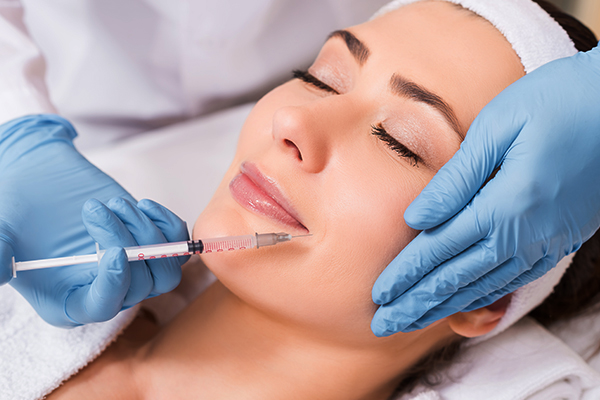
Skin gets its color by deposition of melanin, produced by melanocytes. There are many topical depigmenting agents such as hydroquinone, glycolic acid, arbutin, kojic acid, Vitamin C, Vitamin E and niacinamide. But the most effective and complaint way to bring a glow to your face is by taking systemic oral/IV Glutathione.
Glutathione, is one of the skin whitening agents, is an antioxidant. It promotes pheomelanin, by converting eumelanin and preventing tyrosinase enzyme. It is also used in PMLE, acne vulgaris, vitiligo, psoriasis, anti-aging etc. It is small, low molecular weight thiol tripeptide made up of glutamate, cysteine, and glycine. It is in 2 forms: Reduced glutathione (GSH) and oxidized glutathione (GSSG). GSH is converted to GSSG when it combats with free radicals. Oral antioxidants reduce melanin by scavenging with free radicals produced by UV radiation. Natural sources of glutathione are fresh fruits, tomatoes, avocado, asparagus, walnuts etc.
Glutathione for skin lightening is taken either topical, oral and IV injections.
Topical— as facewash, creams, soaps. Significant reduction in melanin index is seen usually after 10 weeks.
Oral—It has a low bioavailability. It is taken alone or as combination. Efficacy of glutathione is increased when given along with NAC, lipolic acid, vitamin C, Vitamin E etc.
IV— 600-1200mg weekly once is recommended for skin lightening. 100% bioavailability of glutathione.
Oral—It has a low bioavailability. It is taken alone or as combination. Efficacy of glutathione is increased when given along with NAC, lipolic acid, vitamin C, Vitamin E etc.
IV— 600-1200mg weekly once is recommended for skin lightening. 100% bioavailability of glutathione.
What to expect when getting an Vitamin Drip treatment?
- The IV fluids will be administered directly into the vein through a catheter by our team of medical experts,
- The duration of the treatment is typically 30-45 minutes
Before the procedure – We will begin by taking your blood pressure to ensure the treatment is safely administered. Patients are advised to eat a proper meal before their treatment to avoid feeling lightheaded.
During the procedure – The IV is inserted into the vein through a small plastic butterfly vein catheter designed for comfort. Once inserted, the IV drip will slowly begin. The speed of the drip can be increased or decreased depending on the patient’s tolerance.
After the procedure – Immediately after receiving IV fluids, your body will begin to replenish hydration and electrolytes. In most cases, patients feel energized and refreshed after the treatment and continue to benefit for a few days to weeks afterward.
During the procedure – The IV is inserted into the vein through a small plastic butterfly vein catheter designed for comfort. Once inserted, the IV drip will slowly begin. The speed of the drip can be increased or decreased depending on the patient’s tolerance.
After the procedure – Immediately after receiving IV fluids, your body will begin to replenish hydration and electrolytes. In most cases, patients feel energized and refreshed after the treatment and continue to benefit for a few days to weeks afterward.
FAQ
What is Glutathione skin whitening treatment?
Glutathione – a powerful antioxidant and skin brightener: Repairs damaged skin and hair by connecting peptides and proteins. They also strengthen the surface of the skin, making fine lines and wrinkles less deep, and ensuring the skin is hydrated.
How does Glutathione work for skin whitening?
It inhibits Tyrosinase enzyme which has a major role in production of melanin, thereby lightening the skin color.
How long does it take to see results with Glutathione for skin whitening?
1 session every week for first 5 weeks followed by maintenance once in two weeks for next 5 weeks depending upon patients skin type is the recommended protocol. If desired results are not achieved the treatment phase can go for longer
Are there potential side effects of Glutathione skin whitening treatment?
It can range from mild rash to rare serious SJS and TEN, thyroid dysfunction, kidney dysfunction, abdominal pain and fatal complications like air embolism and sepsis due to incorrect injection technique.
Can Glutathione supplements be used for hyperpigmentation or melasma?
Yes, it is recommended to take oral Glutathione for hyperpigmentation and Melasma, as it reduces both melanin synthesis and oxidative stress.
It is taken alone or as combination. Efficacy of glutathione is increased when given along with NAC, lipolic acid, vitamin C, Vitamin E etc.
Can Glutathione be combined with other skin-lightening treatments?
It can be combined with peels, laser tonning, skin boosters and medifacials safely.
Who should avoid Glutathione for skin whitening?
- – Patients with kidney disease or heart disease may not be able to process high vitamin concentrations at once.
- – pregnancy and breast feeding.
- – Patients with high blood pressure should not get IV therapy
IS there DOWNTIME for IV DRIP?
No, IV therapy requires no downtime. In fact, patients will feel immediately energized and hydrated, allowing you to function at your maximum potential. Patients can enjoy the benefits of IV therapy and immediately return to their normal activities.
Is the use of Glutathione for skin whitening is a safe procedure?
It is an absolutely safe process, however some of the SIDE EFFECTS OF GLUTATHIONE INJECTION should be kept in mind.
